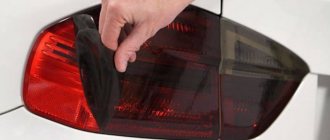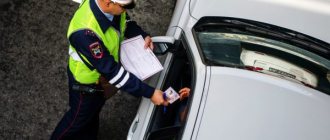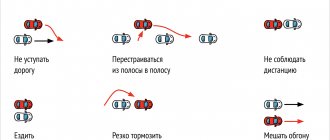Tinting rules in 2021
Acceptable glass tinting according to GOST. The guest says that for the windshield the light transmission value for the windshield is at least 75%, and for the remaining front windows - 70%. The higher the percentage, the more light enters the car interior through the glass.
However, according to the technical regulations of the Customs Union, front windows, including the windshield, must transmit at least 70% of the light. Traffic police officers use data from this regulation, and not from GOST. This means that for all front windows the light transmission value must be at least 70%.
Checking the tint level. To check how much light glass lets in, inspectors use a special device called a taumeter. It consists of two parts - a light source and a receiver. The inspector places the emitter on the outside of the glass, and the receiver on the inside. The more light the receiver receives, the higher the transmission percentage.
The weather during the measurement is not important. Previously, the taumeter had to be calibrated each time to the light level at different times of the day. Modern devices have their own light source, and the level of natural light does not affect the result.
How much light should tinted glass let in?
This is how the inspector measures light transmittance. The device has an emitter on one side and a light receiver on the other. Source: meta-moscow.ru
Glass tinting standards
The main innovation of this law is the change to GOST, which regulates the level of light transmission of tinted car glass.
The new GOST involves dividing all car glass into 2 categories:
- Category No. 1 – glass that provides the driver with front visibility;
- Category No. 2 – glass that provides the driver with rear visibility.
What percentage of tint is allowed? Permitted tinting of front windows (first category) according to GOST is determined by the following light transmittance coefficients:
- windshield tinting according to GOST – 75%;
- tinting on the side front windows – 70%;
- According to GOST, tinting the rear windows of a car is not limited only if the car is equipped with side mirrors on both sides for rear view;
- In the upper area of the windshield, tinting of any light transmittance is permitted, but the width of the tinting coating is limited to 140 mm.
It is worth noting that traffic regulations permit the use of curtains for buses, window blinds and blinds for the rear windows of a passenger car, which is equipped with two rear-view mirrors on both sides.
So, the new standard allows you to curtain or tint the rear window of a car with any type of tint.
Video: Tinting car windows. What tint is acceptable?
Traffic police fine for tinting in 2021
Fine for tinting the windshield. If the windshield transmits less than 70% of the light, the driver will receive a fine of 500 rubles.
Fine for tinting front windows. The fine is the same - 500 rubles if the glass transmits less than 70% of the light.
Penalty for tinting headlights and taillights. If the front lights are any color other than white, yellow and orange, the driver will be disqualified for up to a year. This is said in Part 3 of Art. 12.5 Code of Administrative Offences.
The requirements for taillights are similar: they must not be a color other than red, yellow or orange. The reverse lights and the light above the license plate must be white.
Is tinting allowed for 2021?
Yes. Allowed, but not everything is so clear...
If we are talking about news that has appeared on the Internet that some new law has allegedly been issued, which one way or another lifts the ban on tinting car windows, then there is simply no such law. It is impossible to prove its absence, so we can only suggest looking for its presence in the current legislation. But we regularly monitor changes in regulations and can safely say that as of May 27, 2021, there were no innovations and are not yet expected.
Update as of January 15, 2021: rumors that tinting is allowed again began to actively spread on the Internet. Moreover, even the date is mentioned - February 30, 2021. This is also not true, if only because such a date does not exist, and the latest news about this is nothing more than “fake”. Moreover, the authorities are considering increasing the amount of sanctions for tinted windows.
Update as of September 14, 2021: The Ministry of Transport has prepared draft amendments to the traffic rules regarding tinting. And almost immediately information appeared online about the supposed lifting of the ban on tinted windows. However, the draft amendments to the Rules contain only a clarification of the reference to light transmittance in the Technical Regulations instead of the outdated GOST. The current requirement for light transmittance of 70% is contained in the regulations. And GOST, which regulates the mandatory requirement of 75% of transmitted light, has long lost force.
Update as of June 24, 2019: LDPR deputies proposed to completely abolish the fine for tinting as such - that is, to invalidate the corresponding standard of punishment under the Code of Administrative Offenses. The fact that such a bill with amendments will enter into force is very low.
However, the subtlety lies in the fact that tinting as such has never been prohibited at all - even the front hemisphere of car windows. The exception is mirror tinting, which, on the contrary, was almost always prohibited.
So, tinting may be permissive, but what is it?
It is possible to darken the windows of the front of the car, but the only question is light transmittance and how to drive such a car. Simply put, the issue is the very letter of the law. And, according to the collection of these letters that make up the syllables and in the subsequent sentence, you are allowed to:
- tint the car windows at least 100%, completely seal them with an opaque film, or at worst, cover them with plywood... But all this is provided that you do not drive a car - operation and driving with tinting is prohibited, but also not with any,
- You can drive a car with tinted front windows if their light transmittance remains at least 70% - that is, they transmit through themselves (in any direction) at least 70 percent of the light trying to pass through such windows.
You will also be interested in:
- New traffic regulations: The traffic police have prepared amendments and fines - is this true or not? When do they take effect?
- All about the new warning in the police in questions and answers
- New traffic police fines and amendments to laws from February 1 and 20 - is this true or not?
There is just a significant nuance - resolving tinting, which provides legal light transmittance, is not actually tinting at all - it will be useless for you in its main purpose - to darken the windows. The truth is that even athermal film does not always provide light transmission above the specified percentage.
For example, here is a wonderful Tesla car with an example of permitted tinting with a light transmittance above 70%
Where are the “proofs”?
Everything is very simple! The very fact of driving a car comes from traffic rules, which should be elementary for us as drivers. In particular, the Appendix to the Traffic Regulations “List of faults for which the operation of a car is prohibited” states that:
7.3. Additional objects have been installed or coatings have been applied that restrict visibility from the driver's seat.
That is, it is the operation of the car that is prohibited under such conditions.
And the Administrative Code, which provides for a fine for tinting, also speaks about management:
3.1. Driving a vehicle with glass (including glass covered with transparent colored films) whose light transmission does not meet the requirements of the technical regulations on the safety of wheeled vehicles is subject to an administrative fine of five hundred rubles.
What about 70%? As we can see, the Code of Administrative Offenses refers us to the Technical Regulations - the latter regulates the technical component of the car design and various components and additions to vehicles. In particular, Appendix 8 of the TR establishes the requirements for vehicles in operation, and section 4 of it tells us the following:
4.3. The light transmission of the windshield and windows through which forward visibility is provided to the driver must be at least 70%.
In fact, we find that tinting is permitted and has always been permitted.
How to avoid getting fined for tinting
Do not glue “blind” tint. Because of it, in the dark, the driver will not be able to notice the danger and react in time - people may get hurt. Such tinting does not let in the required 70% of light - there will be a fine.
Remove the film on site. If an inspector stops you and makes a complaint about the tinting, some drivers remove the film on the spot. Others, to make it easier to return the darkening back, use frame curtains - it’s easier to remove and install them.
Sometimes this helps avoid a fine, but more often a fine is issued.
Pay half the fine. In the first 20 days from the date of the decision, the fine can be paid with a 50% discount. In total, instead of 500, the driver will pay 250 rubles.
Mesh frame curtains for front and rear side windows. Installation takes 10 minutes. Source: ozon.ru
How to challenge a fine for tinting
If the driver has eliminated the reasons for the stop, but the inspector still issues a report, a video recording of what is happening will help. Record how you remove the film at the traffic police post. Next, proceed step by step.
Write a complaint. The document must be drawn up in the name of the head of the department whose employee issued the resolution. This data can be viewed in a paper resolution or contact the city traffic police department.
Next, indicate the circumstances under which the report was issued to you and explain why you do not agree with the inspector’s decision. In the attachment, please describe copies of the attached documents - MTPL policy, driver's license, STS and civil passport. Don’t forget to attach a video recording of the film dismantling and the inspector’s work - on a flash drive or disk.
File a complaint. This can be done by registered mail or with a personal visit. The appeal period is 10 days from the day the decision was made.
Wait for a response. The complaint will be considered within 10 days. If the complaint is rejected, the driver can sue the inspector's actions. But because of such a sum, they rarely go to court - almost never.
Remember
- The front windows of a car must allow at least 70% of light into the cabin.
- The amount of light is measured with a special device - a taumeter. You can measure even at night - the device has its own light source.
- The fine for tinting windows is 500 rubles. The repeated fine is the same.
- To avoid getting fined for tinting, do not cover your car windows with it. Sometimes you can avoid a fine if you remove the film on the spot.
- If you do not agree with the fine, write a complaint to the traffic police. In the main part of the document, describe the essence of what happened and argue for the cancellation of the fine. The answer will be given within 10 days.
All articles by the author: Evgeniy Lesnov
Features of proper tinting
For the first time, the very concept of car glass with a polymer coating was legalized! Therefore, it is now possible to tint vehicle windows yourself, not only by covering the glass with films specially designed for this purpose outside and inside the cabin, but also by spraying.
What kind of tint can be applied to front windows? In the latest GOST, almost everything is allowed, but the main thing is to adhere to the permitted percentage of light transmission on the front windows, and this, you see, is not difficult.
Mirror tinting
Is mirror tinting allowed on cars or not? The adopted State Standard does not directly prohibit it, however, the technical regulations of the vehicle provide for the inadmissibility of creating a mirror effect on auto glass.
This requirement is quite justified, since if the car in front reflects the light of the headlights, this can either distract the driver’s attention or completely blind him.
As a result, there is a high chance of an accident occurring, which means that the ban in the technical regulations is quite fair.
What should law-abiding drivers take into account in order to avoid violating this paragraph of the technical regulations of the vehicle?
When choosing a tint, you should know that a metallized film with a transmittance greater than 60% creates a mirror effect, so choose one that meets the above criteria.
Chameleon tinting
Is chameleon tinting allowed according to GOST? What is said about it in the technical regulations of the CU and the adopted GOST?
This type of tinting corresponds to the definition of “safe light-heat-protective glass”, which is found in the above documentation.
The fact is that most athermal films (another name is “chameleon”) have a high light transmission coefficient, which is equal to 80%, and this falls under the term of acceptable tinting of front windows according to GOST.
Despite this, when choosing a chameleon tint, pay special attention to the percentage of its light transmittance - a high-quality film will certainly comply with GOST. To be sure of this, you must request a certificate from suppliers that indicates this percentage.
Chameleon tinting has a number of important advantages:
- The air conditioner runs less;
- the interior heating level has been reduced;
- light in the IR spectrum is reflected;
- Car interior finishing materials do not fade.
So, is athermal tinting allowed according to GOST? In general, yes, but it may be prohibited if it creates a mirror effect.











